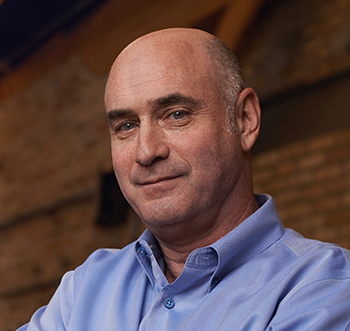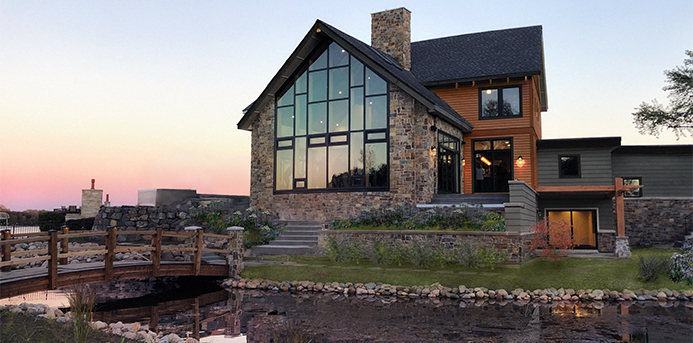Caption: A Lake Zurich solar home completed in 2018. The home was designed to capture key views out to the lake and features a long list of sustainable features including a significant solar panel array. (Photos courtesy of Kipnis Architecture + Planning.)
Incorporating sustainability into the home has never been more critical, not only for the longevity of the planet, but also for cost-efficiency, and, of course, your home’s resale value. Evanston’s Kipnis Architecture + Planning (KAP) is built on the architectural design philosophy of “High Design/Low Carbon™.” The firm is dedicated to both the best in class sustainable architectural practice and top-notch design. As advocates for the AIA 2030 Commitment, KAP is continuously working toward a goal of being a “net zero” company by 2030.
We asked Nathan Kipnis, FAIA, principal of Kipnis Architecture + Planning, to share more about the mission and passions that drive the dedicated team. Kipnis is a Fellow of the American Institute of Architects; AIA’s highest membership honor. Only three percent of AIA members hold the fellowship title.

Make It Better: Briefly describe your business philosophy.
Nathan Kipnis: Founded in 1993, Kipnis Architecture + Planning (KAP) in Evanston has long espoused and practiced the architectural design philosophy of “High Design/Low Carbon™.” We take a thoughtful approach to architectural design, believing that sustainability doesn’t require sacrifice. Green design actually expands the possibilities for innovative architectural forms, construction methods and the use of materials.
Our team at KAP is guided by this philosophy across our award-winning architecture, from renovation and rehabilitation of historic homes to seamless additions and new construction. At the same time, the firm is dedicated to significantly improving energy efficiency and reducing CO2 emissions; as an early adopter of the American Institute of Architects 2030 Commitment. Ultimately, our goal is to design excellent spaces that are efficient in resources and energy that meet clients’ needs and lifestyles, all while being mindful of budgets.
Which product (or service) that you offer is your favorite, and why?
We focus on sustainable homes, including vacation homes. And while sustainable design can be a technical solution, we like to see how we can personalize certain aspects of sustainable concepts.
What is really fun to do is when we can integrate a solar “birthday” monument into a design. We ask the family when their birthdays are and then figure out how to get specific sun angles to align to illuminate a key element of the house on their birthdays! Sort of like a 21st century version of the temple scene in “Raiders of the Lost Ark!”
Tell us about how your business gives back to the community and which organizations or initiatives you’re most passionate about supporting. Why is that important to your organization?
As a firm, KAP’s philosophy of architecture extends to the community in the ways in which people live lighter upon the earth; not only in their homes, but also in their neighborhoods.
On a personal basis, I have provided significant pro bono work over the last 10 years, with the last two years as the national co-chair for the AIA’s 2030 Commitment. The goal of the 2030 Commitment is to support architects to rapidly transform the built environment from the major contributor of greenhouse gas emissions to a central part of the solution to the climate and energy crisis.
I am also a founding board member of Citizens’ Greener Evanston (CGE), which was formed in 2006 to help the City of Evanston reduce its carbon footprint.
My passion for this cause has spurred me to complete two 300-plus mile fundraising “Climate Rides” via bicycle to bring awareness to climate change and raise money for groups that make a difference. I have donated my funds to the Natural Resource Defense Council (NRDC), Architecture 2030 and Citizens’ Greener Evanston.
How has your business adapted to support the demands of consumers for more sustainable and socially responsible products and services?
Integrating sustainable design with great design has been our charge since our inception and is reflected in our tagline of “High Design/Low Carbon™.”
Even if clients aren’t initially ready for certain sustainable aspects to be included in the design, we understand the trends of where environmental design is headed. We can still pre-wire for solar photovoltaic panels and electric car charging in the garage.
The homes are not only high performance and energy efficient, but they are also healthy and resilient. Resilient design is the ability of a home to adapt to changing conditions and to maintain or regain functionality and vitality in the face of stress or disturbance.
Over time, we have found that more and more clients understand why this is important. The comfort in a sustainable home is vastly better. Having a home ready to handle power outages, high wind and extreme rain provides not only peace of mind, but also will enhance the resale potential of a home. The cost on the margin to incorporate these technologies is not significant and is getting more affordable every year.
We believe that we’re all better together. Tell us which businesses or individuals in the community you love to work with and support.
I am the founding member of NextHaus Alliance, “visionary people building the future.” NextHaus Alliance is an allied group of design and build professionals whose mission is to create beautiful and inspiring sustainable environments that provide peace of mind for visionary clientele. The group is made up of our firm, Janet McCann Interior Design, Berliant Builders, Hursthouse Landscape Architects, and Barrett’s Technology Solutions for the technology integration. We are also partners with Night Light Inc. for exterior illumination.
We are very excited about the ability to design amazing homes that use this integrated design approach and are designed with not only sustainability but also are resiliently designed to be able to handle the ‘new normal’ weather extremes that we are seeing.

